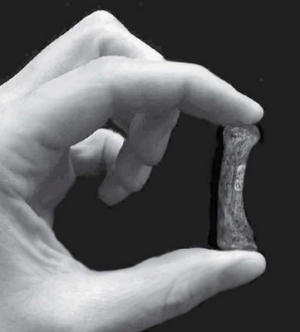Human Evolution and the Precision Grip

By Julianne Glauser
Picture an image of our earliest ancestors such as such as Homo erectus. What do you see? For many, we imagine a primitive, “ape-like” creature with brute strength but little finesse. Recent research, however, reveals ancient hominins that lived nearly 3 million years ago may have developed the fine motor movement for a precision grip, allowing them to wrap their thumbs and fingers tightly around objects. Precision grip is ability to touch the index fingertip with the tip of the thumb. Researchers are now speculating that this precision grip may have allowed our ancestors to create and use stone tools much earlier than previously believed.
Who Was the Original Toolmaker?
Paleoanthropologists have discovered fossil records of the earliest stone tools in Gona, Ethiopia, that date back nearly 2.6 million years. The identity of the original toolmakers eluded researchers for years, because several hominin species dominated during this period, including Homo, our ancestral genus, and several species of close relatives, such as Australopithecus, including A. afarensis, the species of the famous Lucy skeleton. Identification has been further complicated by the fact that complete, intact fossils of delicate hand bones are nearly impossible to unearth. In a groundbreaking study, paleoanthropologists Matthew Skinner and Tracy Kivell at the University of Kent and Max Planck Institute for Evolutionary Anthropology implemented an innovative CT scanning technique to extract a more intricate glimpse at the internal structure of hand bones. Skinner and Kivell examined the pattern of fossilized spongy bone tissue in the hand bones of hominins that lived two to three million years ago to determine signs of habitual, repetitive hand movements. Scanning results indicated that the South American A. africanus species exhibited an asymmetrical pattern of trabecular bone tissue, which develops at the base of the thumb and knuckles as a result of precision gripping, similar to modern humans. This suggests that A. africanus developed the ability to handle stone tools more than half a million years before the earliest fossil record of stone tools had previously indicated. To validate a direct correlation between precision grip and tool use, paleoanthropologists are searching for stone tools in several early Australopithecus locations. Paleoanthropologist C. Owen Lovejoy of Kent State University in Ohio cautions that “other activities that hominins engaged in frequently during development, such as digging tubers or climbing, might also explain the signs of stress.” Future studies are necessary to confirm Australopithecus tool use and the emergence of the precision grip in other related hominins.
Extension Questions
- What advantage does the precision grip provide?
- What are some possible reasons that A. africanus developed a precision grip before A. afarensis?

